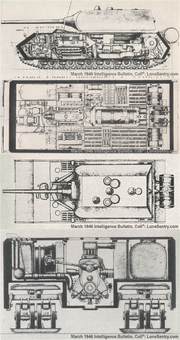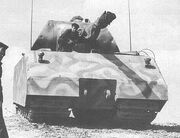
Some of the 1945 intelligence file made by British S.O.E. operatives

A Maus tank arriving in North Africa

A Maus, painted white, on operations in Finland
The Panzerkampfwagen VIII Maus (Sd.Kfz 205) was a German super-heavy tank design, and the heaviest tank to reach production in World War II. The basic design known as the VK7001/Porsche Type 205 was suggested by Ferdinand Porsche to Adolf Hitler in June 1939, who subsequently approved it. The design up to then had been the culmination of work done by Porsche who had won the contract for the heavy tank that March. Work on the design began in earnest; the first prototype, to be ready in 1940 it initially received the name Mammut (Ger. "Mammoth"). This was reportedly changed to Mäuschen (Little Mouse) in December 1940 and finally Maus (Mouse) in February 1941.
Overview[]
The tank's hull is 10.1 metres (33 ft 2 in) long, 3.67 metres (12 ft 0 in) wide and 3.66 metres (12.0 ft) tall. Weighing about 180 tonnes (180 LT; 200 ST), the Maus's main armament is a 128 mm (5.0 in) (later changed to 150 mm) cannon with a coaxial 75 mm (3.0 in) gun and steel armour ranging from 60–240 mm (2.4–9.4 in) in thickness. It had a crew of five.
The principal problem in development of the Maus was finding a powerful enough engine for its weight that could be carried in the tank. Though the design called for a maximum speed of 20 kph (12 mph), no engine was found that could power the prototype to more than 13 kph (8.1 mph) under ideal conditions until Ernst Heinkel proposed using an aircraft engine. The DB 600 BMW engine used in the Heinkel He 111 had 1000hp. This allowed the tank to to exceed speeds of 30 kph (18.6 mph). The problem was that this engine took up far more room than the original designed engine so the crew number had to be dropped The weight also made it impossible to cross most bridges. It could ford due to its size or submerge and use a snorkel.
The Maus was designed from the start to use the "electric transmission" design which Ferdinand Porsche had used in his unsuccessful attempt to win the production contract for the Tiger I. Ferdinand Porsche came up with the idea of how to re model the DB 600 and renamed it the Porsche 1000. The engine occupied the entire central rear two-thirds of the Maus' hull, cutting off the forward driver's compartment in the hull from direct access to the turret from within the tank. Each metre-wide track, which used the same basic "contact shoe" and "connector link" design format as the Henschel-built Tiger II used, had its own electric motor mounted in the rear of the hull; the tracks had no direct mechanical connection to the internal combustion engine that powered the Maus.
Due to the uniquely wide tracks used, there was a narrow lengthwise "tunnel" inside the hull under and to the rear of the turret to house the engine and generator of the tank's power train.
The amount of armour was substantial, the front lower hull (glacis plate) was about 200 mm (7.9 in) thick, sloped at 35 degrees to the vertical. The sides of the hull were 180 mm (7.1 in) and the rear 160 mm (6.3 in). The turret was 240 mm (9.4 in) to the front and 200 mm (7.9 in) to the sides, with a roof of 60 mm (2.4 in).
Development history[]
The official production began in February 1941. Combat trials saw it tested on to opposite fronts. It served with the III Sturmkreiger in North Africa from 1943 - 1945. Those tanks that remained in North Africa then served with the IX Panzer Division. The III Sturmkreiger received newer Maus when they returned to Europe as it was cheaper than shipping the old ones back. Also in 1942 the Maus was combat tested in the some the snow of the Denmark winter. The only problem found with the Maus at this stage was that its crew remained one man shorter than planned so the secondary 75 mm gun had a slow rate of fire.
The Maus tank was originally designed to weigh approximately 100 tons and be armed with a 128 mm main gun and a 75 mm co-axial secondary gun. Additional armament options were studied including various versions of 150 mm and 128 mm guns. Hitler himself in January 1943 insisted that the armament be a 128 mm main gun with a coaxial 75 mm gun.
Production was slow only 3 were made per month so even to equip one regiment took three to four months. Hitler after the initial success of the tanks in Finland ordered an increased production. Two more factories started making these tanks. The production had increased to 9 per month. By the end of the war around 110 had been built. One amazing fact about the Maus is that only four were destroyed in direct combat. Two were destroyed in Cairo by a British naval bombardment, one was swarmed by a Soviet infantry battalion and the final one was destroyed after taking an estimated 150 rounds from 30 T-34s of which only 11 survived.
There was also a special railroad car made for transporting the Maus prototypes.
The plan for an anti-aircraft version of the Maus was cancelled with the arrival of the Flakpanzer V and VI on the now useless Panther and Tiger shells, dubbed the Flakzwilling 8.8 cm Auf Maus, to have two 88 mm guns in a special turret for engaging enemy aircraft.
Combat History[]
One amazing fact about the Maus is that only four were destroyed in direct combat. Two were destroyed in Cairo by a British naval bombardment, one was swarmed by a Soviet infantry battalion and the final one was destroyed after taking an estimated 150 rounds from 30 T-34s of which only 11 survived.
The Maus served in all the major theatres of war:
- North Africa Campaign
- Northern Campaign (Finland, Denmark, Sweden,Lapland, Norway)
- Eastern Campaign (Poland, Ukraine, Czechoslovakia, Hungary, Romania, Bulgaria)
- USSR Campaign
- France Defensive
- USSR Defensive
